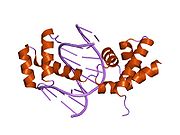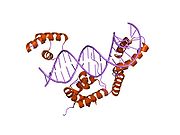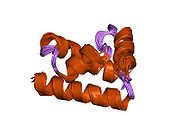- POU2F1
-
POU class 2 homeobox 1 
PDB rendering based on 1cqt.Available structures PDB 1CQT, 1E3O, 1GT0, 1HF0, 1O4X, 1OCT, 1POG, 1POU Identifiers Symbols POU2F1; FLJ42836; OCT1; OTF1 External IDs OMIM: 164175 MGI: 101898 HomoloGene: 37658 GeneCards: POU2F1 Gene Gene Ontology Molecular function • sequence-specific DNA binding transcription factor activity
• protein binding
• sequence-specific DNA bindingCellular component • nucleus
• nucleoplasmBiological process • regulation of transcription, DNA-dependent
• transcription from RNA polymerase III promoter
• negative regulation of transcription, DNA-dependentSources: Amigo / QuickGO RNA expression pattern 
More reference expression data Orthologs Species Human Mouse Entrez 5451 18986 Ensembl ENSG00000143190 ENSMUSG00000026565 UniProt P14859 Q8C4C1 RefSeq (mRNA) NM_001198783.1 NM_011137 RefSeq (protein) NP_001185712.1 NP_035267 Location (UCSC) Chr 1:
167.19 – 167.4 MbChr 1:
167.8 – 167.93 MbPubMed search [1] [2] POU domain, class 2, transcription factor 1 is a protein that in humans is encoded by the POU2F1 gene.[1][2]
Contents
Interactions
POU2F1 has been shown to interact with SNAPC4,[3][4] Ku80,[5][6] Glucocorticoid receptor,[7][8][9] Sp1 transcription factor,[10][11] NPAT,[12] POU2AF1,[4][13][14] Host cell factor C1,[15][16] TATA binding protein,[17] RELA,[18] Nuclear receptor co-repressor 2,[19] EPRS,[20] Glyceraldehyde 3-phosphate dehydrogenase,[12] MNAT1[21] and Retinoid X receptor alpha.[7][22]
See also
References
- ^ Roberts SB, Segil N, Heintz N (Oct 1991). "Differential phosphorylation of the transcription factor Oct1 during the cell cycle". Science 253 (5023): 1022–6. doi:10.1126/science.1887216. PMID 1887216.
- ^ "Entrez Gene: POU2F1 POU domain, class 2, transcription factor 1". http://www.ncbi.nlm.nih.gov/sites/entrez?Db=gene&Cmd=ShowDetailView&TermToSearch=5451.
- ^ Hovde, Stacy; Brooks Aimee, Strong Katie, Geiger James H (Mar. 2002). "Crystallization of the Oct-1/SNAP190 peptide/DNA complex". Acta Crystallogr. D Biol. Crystallogr. (Denmark) 58 (Pt 3): 511–2. doi:10.1107/S0907444901021461. ISSN 0907-4449. PMID 11856838.
- ^ a b Wong, M W; Henry R W, Ma B, Kobayashi R, Klages N, Matthias P, Strubin M, Hernandez N (Jan. 1998). "The Large Subunit of Basal Transcription Factor SNAPc Is a Myb Domain Protein That Interacts with Oct-1". Mol. Cell. Biol. (UNITED STATES) 18 (1): 368–77. ISSN 0270-7306. PMC 121507. PMID 9418884. http://www.pubmedcentral.nih.gov/articlerender.fcgi?tool=pmcentrez&artid=121507.
- ^ Schild-Poulter, C; Pope L, Giffin W, Kochan J C, Ngsee J K, Traykova-Andonova M, Haché R J (May. 2001). "The binding of Ku antigen to homeodomain proteins promotes their phosphorylation by DNA-dependent protein kinase". J. Biol. Chem. (United States) 276 (20): 16848–56. doi:10.1074/jbc.M100768200. ISSN 0021-9258. PMID 11279128.
- ^ Matheos, Diamanto; Ruiz Marcia T, Price Gerald B, Zannis-Hadjopoulos Maria (Oct. 2002). "Ku antigen, an origin-specific binding protein that associates with replication proteins, is required for mammalian DNA replication". Biochim. Biophys. Acta (Netherlands) 1578 (1–3): 59–72. ISSN 0006-3002. PMID 12393188.
- ^ a b Préfontaine, G G; Walther R, Giffin W, Lemieux M E, Pope L, Haché R J (Sep. 1999). "Selective binding of steroid hormone receptors to octamer transcription factors determines transcriptional synergism at the mouse mammary tumor virus promoter". J. Biol. Chem. (UNITED STATES) 274 (38): 26713–9. doi:10.1074/jbc.274.38.26713. ISSN 0021-9258. PMID 10480874.
- ^ Wang, J M; Préfontaine G G, Lemieux M E, Pope L, Akimenko M A, Haché R J (Oct. 1999). "Developmental Effects of Ectopic Expression of the Glucocorticoid Receptor DNA Binding Domain Are Alleviated by an Amino Acid Substitution That Interferes with Homeodomain Binding". Mol. Cell. Biol. (UNITED STATES) 19 (10): 7106–22. ISSN 0270-7306. PMC 84705. PMID 10490647. http://www.pubmedcentral.nih.gov/articlerender.fcgi?tool=pmcentrez&artid=84705.
- ^ Préfontaine, G G; Lemieux M E, Giffin W, Schild-Poulter C, Pope L, LaCasse E, Walker P, Haché R J (Jun. 1998). "Recruitment of Octamer Transcription Factors to DNA by Glucocorticoid Receptor". Mol. Cell. Biol. (UNITED STATES) 18 (6): 3416–30. ISSN 0270-7306. PMC 108923. PMID 9584182. http://www.pubmedcentral.nih.gov/articlerender.fcgi?tool=pmcentrez&artid=108923.
- ^ Ström, A C; Forsberg M, Lillhager P, Westin G (Jun. 1996). "The transcription factors Sp1 and Oct-1 interact physically to regulate human U2 snRNA gene expression". Nucleic Acids Res. (ENGLAND) 24 (11): 1981–6. doi:10.1093/nar/24.11.1981. ISSN 0305-1048. PMC 145891. PMID 8668525. http://www.pubmedcentral.nih.gov/articlerender.fcgi?tool=pmcentrez&artid=145891.
- ^ Gunther, M; Laithier M, Brison O (Jul. 2000). "A set of proteins interacting with transcription factor Sp1 identified in a two-hybrid screening". Mol. Cell. Biochem. (NETHERLANDS) 210 (1–2): 131–42. doi:10.1023/A:1007177623283. ISSN 0300-8177. PMID 10976766.
- ^ a b Zheng, Lei; Roeder Robert G, Luo Yan (Jul. 2003). "S phase activation of the histone H2B promoter by OCA-S, a coactivator complex that contains GAPDH as a key component". Cell (United States) 114 (2): 255–66. doi:10.1016/S0092-8674(03)00552-X. ISSN 0092-8674. PMID 12887926.
- ^ Chasman, D; Cepek K, Sharp P A, Pabo C O (Oct. 1999). "Crystal structure of an OCA-B peptide bound to an Oct-1 POU domain/octamer DNA complex: specific recognition of a protein-DNA interface". Genes Dev. (UNITED STATES) 13 (20): 2650–7. doi:10.1101/gad.13.20.2650. ISSN 0890-9369. PMC 317104. PMID 10541551. http://www.pubmedcentral.nih.gov/articlerender.fcgi?tool=pmcentrez&artid=317104.
- ^ Lee, L; Stollar E, Chang J, Grossmann J G, O'Brien R, Ladbury J, Carpenter B, Roberts S, Luisi B (Jun. 2001). "Expression of the Oct-1 transcription factor and characterization of its interactions with the Bob1 coactivator". Biochemistry (United States) 40 (22): 6580–8. doi:10.1021/bi010095x. ISSN 0006-2960. PMID 11380252.
- ^ La Boissière, S; Hughes T, O'Hare P (Jan. 1999). "HCF-dependent nuclear import of VP16". EMBO J. (ENGLAND) 18 (2): 480–9. doi:10.1093/emboj/18.2.480. ISSN 0261-4189. PMC 1171141. PMID 9889203. http://www.pubmedcentral.nih.gov/articlerender.fcgi?tool=pmcentrez&artid=1171141.
- ^ Kristie, T M; Sharp P A (Mar. 1993). "Purification of the cellular C1 factor required for the stable recognition of the Oct-1 homeodomain by the herpes simplex virus alpha-trans-induction factor (VP16)". J. Biol. Chem. (UNITED STATES) 268 (9): 6525–34. ISSN 0021-9258. PMID 8454622.
- ^ Zwilling, S; Annweiler A, Wirth T (May. 1994). "The POU domains of the Oct1 and Oct2 transcription factors mediate specific interaction with TBP". Nucleic Acids Res. (ENGLAND) 22 (9): 1655–62. doi:10.1093/nar/22.9.1655. ISSN 0305-1048. PMC 308045. PMID 8202368. http://www.pubmedcentral.nih.gov/articlerender.fcgi?tool=pmcentrez&artid=308045.
- ^ van Heel, David A; Udalova Irina A, De Silva Arjuna P, McGovern Dermot P, Kinouchi Yoshitaka, Hull Jeremy, Lench Nicholas J, Cardon Lon R, Carey Alisoun H, Jewell Derek P, Kwiatkowski Dominic (May. 2002). "Inflammatory bowel disease is associated with a TNF polymorphism that affects an interaction between the OCT1 and NF(-kappa)B transcription factors". Hum. Mol. Genet. (England) 11 (11): 1281–9. doi:10.1093/hmg/11.11.1281. ISSN 0964-6906. PMID 12019209.
- ^ Kakizawa, T; Miyamoto T, Ichikawa K, Takeda T, Suzuki S, Mori J, Kumagai M, Yamashita K, Hashizume K (Mar. 2001). "Silencing mediator for retinoid and thyroid hormone receptors interacts with octamer transcription factor-1 and acts as a transcriptional repressor". J. Biol. Chem. (United States) 276 (13): 9720–5. doi:10.1074/jbc.M008531200. ISSN 0021-9258. PMID 11134019.
- ^ Nie, J; Sakamoto S, Song D, Qu Z, Ota K, Taniguchi T (Mar. 1998). "Interaction of Oct-1 and automodification domain of poly(ADP-ribose) synthetase". FEBS Lett. (NETHERLANDS) 424 (1–2): 27–32. doi:10.1016/S0014-5793(98)00131-8. ISSN 0014-5793. PMID 9537509.
- ^ Inamoto, S; Segil N, Pan Z Q, Kimura M, Roeder R G (Nov. 1997). "The cyclin-dependent kinase-activating kinase (CAK) assembly factor, MAT1, targets and enhances CAK activity on the POU domains of octamer transcription factors". J. Biol. Chem. (UNITED STATES) 272 (47): 29852–8. doi:10.1074/jbc.272.47.29852. ISSN 0021-9258. PMID 9368058.
- ^ Kakizawa, T; Miyamoto T, Ichikawa K, Kaneko A, Suzuki S, Hara M, Nagasawa T, Takeda T, Mori J i, Kumagai M, Hashizume K (Jul. 1999). "Functional interaction between Oct-1 and retinoid X receptor". J. Biol. Chem. (UNITED STATES) 274 (27): 19103–8. doi:10.1074/jbc.274.27.19103. ISSN 0021-9258. PMID 10383413.
Further reading
- Hsieh CL, Sturm R, Herr W, Francke U (1990). "The gene for the ubiquitous octamer-binding protein Oct-1 is on human chromosome 1, region cen-q32, and near Ly-22 and Ltw-4 on mouse chromosome 1". Genomics 6 (4): 666–72. doi:10.1016/0888-7543(90)90502-L. PMID 2341156.
- Sturm RA, Das G, Herr W (1989). "The ubiquitous octamer-binding protein Oct-1 contains a POU domain with a homeo box subdomain". Genes Dev. 2 (12A): 1582–99. doi:10.1101/gad.2.12a.1582. PMID 2905684.
- Nakshatri H, Nakshatri P, Currie RA (1995). "Interaction of Oct-1 with TFIIB. Implications for a novel response elicited through the proximal octamer site of the lipoprotein lipase promoter". J. Biol. Chem. 270 (33): 19613–23. doi:10.1074/jbc.270.33.19613. PMID 7642649.
- Cox M, van Tilborg PJ, de Laat W, et al. (1995). "Solution structure of the Oct-1 POU homeodomain determined by NMR and restrained molecular dynamics". J. Biomol. NMR 6 (1): 23–32. doi:10.1007/BF00417488. PMID 7663141.
- Jeang KT, Chun R, Lin NH, et al. (1993). "In vitro and in vivo binding of human immunodeficiency virus type 1 Tat protein and Sp1 transcription factor". J. Virol. 67 (10): 6224–33. PMC 238044. PMID 7690421. http://www.pubmedcentral.nih.gov/articlerender.fcgi?tool=pmcentrez&artid=238044.
- Zwilling S, König H, Wirth T (1995). "High mobility group protein 2 functionally interacts with the POU domains of octamer transcription factors". EMBO J. 14 (6): 1198–208. PMC 398197. PMID 7720710. http://www.pubmedcentral.nih.gov/articlerender.fcgi?tool=pmcentrez&artid=398197.
- Sturm RA, Eyre HJ, Baker E, Sutherland GR (1995). "The human OTF1 locus which overlaps the CD3Z gene is located at 1q22→q23". Cytogenet. Cell Genet. 68 (3–4): 231–2. doi:10.1159/000133919. PMID 7842742.
- Klemm JD, Rould MA, Aurora R, et al. (1994). "Crystal structure of the Oct-1 POU domain bound to an octamer site: DNA recognition with tethered DNA-binding modules". Cell 77 (1): 21–32. doi:10.1016/0092-8674(94)90231-3. PMID 8156594.
- Zwilling S, Annweiler A, Wirth T (1994). "The POU domains of the Oct1 and Oct2 transcription factors mediate specific interaction with TBP". Nucleic Acids Res. 22 (9): 1655–62. doi:10.1093/nar/22.9.1655. PMC 308045. PMID 8202368. http://www.pubmedcentral.nih.gov/articlerender.fcgi?tool=pmcentrez&artid=308045.
- Kristie TM, Sharp PA (1993). "Purification of the cellular C1 factor required for the stable recognition of the Oct-1 homeodomain by the herpes simplex virus alpha-trans-induction factor (VP16)". J. Biol. Chem. 268 (9): 6525–34. PMID 8454622.
- Assa-Munt N, Mortishire-Smith RJ, Aurora R, et al. (1993). "The solution structure of the Oct-1 POU-specific domain reveals a striking similarity to the bacteriophage lambda repressor DNA-binding domain". Cell 73 (1): 193–205. doi:10.1016/0092-8674(93)90171-L. PMID 8462099.
- Dekker N, Cox M, Boelens R, et al. (1993). "Solution structure of the POU-specific DNA-binding domain of Oct-1". Nature 362 (6423): 852–5. doi:10.1038/362852a0. PMID 8479524.
- Ström AC, Forsberg M, Lillhager P, Westin G (1996). "The transcription factors Sp1 and Oct-1 interact physically to regulate human U2 snRNA gene expression". Nucleic Acids Res. 24 (11): 1981–6. doi:10.1093/nar/24.11.1981. PMC 145891. PMID 8668525. http://www.pubmedcentral.nih.gov/articlerender.fcgi?tool=pmcentrez&artid=145891.
- Inamoto S, Segil N, Pan ZQ, et al. (1997). "The cyclin-dependent kinase-activating kinase (CAK) assembly factor, MAT1, targets and enhances CAK activity on the POU domains of octamer transcription factors". J. Biol. Chem. 272 (47): 29852–8. doi:10.1074/jbc.272.47.29852. PMID 9368058.
- Wong MW, Henry RW, Ma B, et al. (1998). "The Large Subunit of Basal Transcription Factor SNAPc Is a Myb Domain Protein That Interacts with Oct-1". Mol. Cell. Biol. 18 (1): 368–77. PMC 121507. PMID 9418884. http://www.pubmedcentral.nih.gov/articlerender.fcgi?tool=pmcentrez&artid=121507.
- Nie J, Sakamoto S, Song D, et al. (1998). "Interaction of Oct-1 and automodification domain of poly(ADP-ribose) synthetase". FEBS Lett. 424 (1–2): 27–32. doi:10.1016/S0014-5793(98)00131-8. PMID 9537509.
- Préfontaine GG, Lemieux ME, Giffin W, et al. (1998). "Recruitment of Octamer Transcription Factors to DNA by Glucocorticoid Receptor". Mol. Cell. Biol. 18 (6): 3416–30. PMC 108923. PMID 9584182. http://www.pubmedcentral.nih.gov/articlerender.fcgi?tool=pmcentrez&artid=108923.
- La Boissière S, Hughes T, O'Hare P (1999). "HCF-dependent nuclear import of VP16". EMBO J. 18 (2): 480–9. doi:10.1093/emboj/18.2.480. PMC 1171141. PMID 9889203. http://www.pubmedcentral.nih.gov/articlerender.fcgi?tool=pmcentrez&artid=1171141.
- Kakizawa T, Miyamoto T, Ichikawa K, et al. (1999). "Functional interaction between Oct-1 and retinoid X receptor". J. Biol. Chem. 274 (27): 19103–8. doi:10.1074/jbc.274.27.19103. PMID 10383413.
PDB gallery 1cqt: CRYSTAL STRUCTURE OF A TERNARY COMPLEX CONTAINING AN OCA-B PEPTIDE, THE OCT-1 POU DOMAIN, AND AN OCTAMER ELEMENT1e3o: CRYSTAL STRUCTURE OF OCT-1 POU DIMER BOUND TO MORE1gt0: CRYSTAL STRUCTURE OF A POU/HMG/DNA TERNARY COMPLEX1hf0: CRYSTAL STRUCTURE OF THE DNA-BINDING DOMAIN OF OCT-1 BOUND TO DNA AS A DIMER1o4x: TERNARY COMPLEX OF THE DNA BINDING DOMAINS OF THE OCT1 AND SOX2 TRANSCRIPTION FACTORS WITH A 19MER OLIGONUCLEOTIDE FROM THE HOXB1 REGULATORY ELEMENT1oct: CRYSTAL STRUCTURE OF THE OCT-1 POU DOMAIN BOUND TO AN OCTAMER SITE: DNA RECOGNITION WITH TETHERED DNA-BINDING MODULES1pog: SOLUTION STRUCTURE OF THE OCT-1 POU-HOMEO DOMAIN DETERMINED BY NMR AND RESTRAINED MOLECULAR DYNAMICS1pou: THE SOLUTION STRUCTURE OF THE OCT-1 POU-SPECIFIC DOMAIN REVEALS A STRIKING SIMILARITY TO THE BACTERIOPHAGE LAMBDA REPRESSOR DNA-BINDING DOMAINExternal links
Transcription factors and intracellular receptors (1) Basic domains (1.1) Basic leucine zipper (bZIP)Activating transcription factor (AATF, 1, 2, 3, 4, 5, 6, 7) · AP-1 (c-Fos, FOSB, FOSL1, FOSL2, JDP2, c-Jun, JUNB, JUND) · BACH (1, 2) · BATF · BLZF1 · C/EBP (α, β, γ, δ, ε, ζ) · CREB (1, 3, L1) · CREM · DBP · DDIT3 · GABPA · HLF · MAF (B, F, G, K) · NFE (2, L1, L2, L3) · NFIL3 · NRL · NRF (1, 2, 3) · XBP1(1.2) Basic helix-loop-helix (bHLH)ATOH1 · AhR · AHRR · ARNT · ASCL1 · BHLHB2 · BMAL (ARNTL, ARNTL2) · CLOCK · EPAS1 · FIGLA · HAND (1, 2) · HES (5, 6) · HEY (1, 2, L) · HES1 · HIF (1A, 3A) · ID (1, 2, 3, 4) · LYL1 · MESP2 · MXD4 · MYCL1 · MYCN · Myogenic regulatory factors (MyoD, Myogenin, MYF5, MYF6) · Neurogenins (1, 2, 3) · NeuroD (1, 2) · NPAS (1, 2, 3) · OLIG (1, 2) · Pho4 · Scleraxis · SIM (1, 2) · TAL (1, 2) · Twist · USF1(1.3) bHLH-ZIP(1.4) NF-1(1.5) RF-X(1.6) Basic helix-span-helix (bHSH)(2) Zinc finger DNA-binding domains (2.1) Nuclear receptor (Cys4)subfamily 1 (Thyroid hormone (α, β), CAR, FXR, LXR (α, β), PPAR (α, β/δ, γ), PXR, RAR (α, β, γ), ROR (α, β, γ), Rev-ErbA (α, β), VDR)
subfamily 2 (COUP-TF (I, II), Ear-2, HNF4 (α, γ), PNR, RXR (α, β, γ), Testicular receptor (2, 4), TLX)
subfamily 3 (Steroid hormone (Androgen, Estrogen (α, β), Glucocorticoid, Mineralocorticoid, Progesterone), Estrogen related (α, β, γ))
subfamily 4 NUR (NGFIB, NOR1, NURR1) · subfamily 5 (LRH-1, SF1) · subfamily 6 (GCNF) · subfamily 0 (DAX1, SHP)(2.2) Other Cys4(2.3) Cys2His2General transcription factors (TFIIA, TFIIB, TFIID, TFIIE (1, 2), TFIIF (1, 2), TFIIH (1, 2, 4, 2I, 3A, 3C1, 3C2))
ATBF1 · BCL (6, 11A, 11B) · CTCF · E4F1 · EGR (1, 2, 3, 4) · ERV3 · GFI1 · GLI-Krüppel family (1, 2, 3, REST, S2, YY1) · HIC (1, 2) · HIVEP (1, 2, 3) · IKZF (1, 2, 3) · ILF (2, 3) · KLF (2, 3, 4, 5, 6, 7, 8, 9, 10, 11, 12, 13, 14, 15, 17) · MTF1 · MYT1 · OSR1 · PRDM9 · SALL (1, 2, 3, 4) · SP (1, 2, 4, 7, 8) · TSHZ3 · WT1 · Zbtb7 (7A, 7B) · ZBTB (16, 17, 20, 32, 33, 40) · zinc finger (3, 7, 9, 10, 19, 22, 24, 33B, 34, 35, 41, 43, 44, 51, 74, 143, 146, 148, 165, 202, 217, 219, 238, 239, 259, 267, 268, 281, 295, 300, 318, 330, 346, 350, 365, 366, 384, 423, 451, 452, 471, 593, 638, 644, 649, 655)(2.4) Cys6(2.5) Alternating composition(3) Helix-turn-helix domains (3.1) HomeodomainARX · CDX (1, 2) · CRX · CUTL1 · DBX (1, 2) · DLX (3, 4, 5) · EMX2 · EN (1, 2) · FHL (1, 2, 3) · HESX1 · HHEX · HLX · Homeobox (A1, A2, A3, A4, A5, A7, A9, A10, A11, A13, B1, B2, B3, B4, B5, B6, B7, B8, B9, B13, C4, C5, C6, C8, C9, C10, C11, C12, C13, D1, D3, D4, D8, D9, D10, D11, D12, D13) · HOPX · IRX (1, 2, 3, 4, 5, 6, MKX) · LMX (1A, 1B) · MEIS (1, 2) · MEOX2 · MNX1 · MSX (1, 2) · NANOG · NKX (2-1, 2-2, 2-3, 2-5, 3-1, 3-2, 6-1, 6-2) · NOBOX · PBX (1, 2, 3) · PHF (1, 3, 6, 8, 10, 16, 17, 20, 21A) · PHOX (2A, 2B) · PITX (1, 2, 3) · POU domain (PIT-1, BRN-3: A, B, C, Octamer transcription factor: 1, 2, 3/4, 6, 7, 11) · OTX (1, 2) · PDX1 · SATB2 · SHOX2 · VAX1 · ZEB (1, 2)(3.2) Paired box(3.3) Fork head / winged helix(3.4) Heat Shock Factors(3.5) Tryptophan clusters(3.6) TEA domain(4) β-Scaffold factors with minor groove contacts (4.1) Rel homology region(4.2) STAT(4.3) p53(4.4) MADS box(4.6) TATA binding proteins(4.7) High-mobility group(4.10) Cold-shock domainCSDA, YBX1(4.11) Runt(0) Other transcription factors (0.2) HMGI(Y)(0.3) Pocket domain(0.6) Miscellaneoussee also transcription factor/coregulator deficiencies
B bsyn: dna (repl, cycl, reco, repr) · tscr (fact, tcrg, nucl, rnat, rept, ptts) · tltn (risu, pttl, nexn) · dnab, rnab/runp · stru (domn, 1°, 2°, 3°, 4°)Categories:- Human proteins
- Transcription factors
- Chromosome 1 gene stubs
Wikimedia Foundation. 2010.








